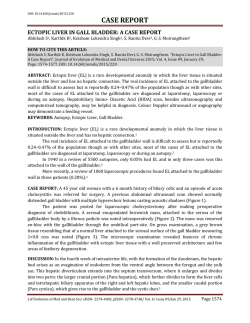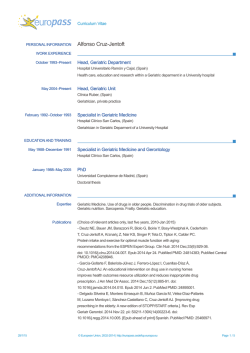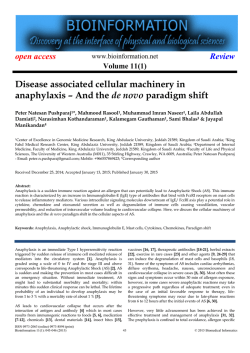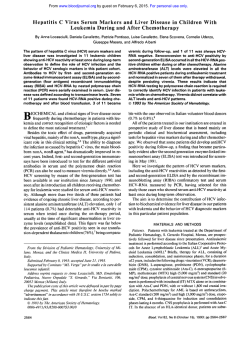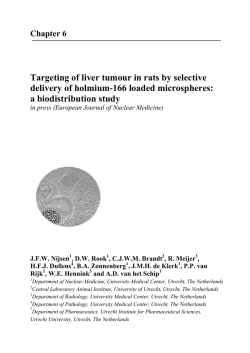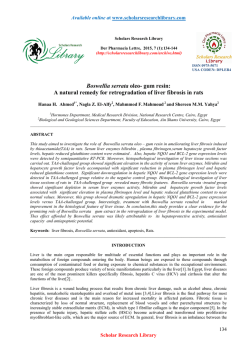
PDF (915K) - World Journal of Gastroenterology
World J Gastroenterol 2015 January 28; 21(4): 1061-1068 ISSN 1007-9327 (print) ISSN 2219-2840 (online) Submit a Manuscript: http://www.wjgnet.com/esps/ Help Desk: http://www.wjgnet.com/esps/helpdesk.aspx DOI: 10.3748/wjg.v21.i4.1061 © 2015 Baishideng Publishing Group Inc. All rights reserved. REVIEW Markers of acute rejection and graft acceptance in liver transplantation Giacomo Germani, Kryssia Rodriguez-Castro, Francesco Paolo Russo, Marco Senzolo, Alberto Zanetto, Alberto Ferrarese, Patrizia Burra immunological system. Various markers have been studied in an attempt to identify a specific indicator of graft rejection and graft acceptance after liver transplantation. Considering acute rejection, the most studied markers are pro-inflammatory and immunoregulatory cytokines and other proteins re lated to inflammation. However there is considerable overlap with other conditions, and only few of them have been validated. Standard liver tests cannot be used as markers of graft rejection due to their low sensitivity and specificity and the weak correlation with the severity of histopathological findings. Several studies have been performed to identify biomarkers of tolerance in liver transplanted patients. Most of them are based on the analysis of peripheral blood samples and on the use of transcriptional profiling techniques. Amongst these, NK cell-related molecules seem to be the most valid marker of graft acceptance, whereas the + + + role CD4 CD25 Foxp3 T cells has still to be properly defined. Giacomo Germani, Kryssia Rodriguez-Castro, Francesco Paolo Russo, Marco Senzolo, Alberto Zanetto, Alberto Ferrarese, Patrizia Burra, Multivisceral Transplant Unit, Department of Surgery, Oncology and Gastroenterology, Padua University Hospital, 35128 Padua, Italy Author contributions: Germani G and Rodriguez-Castro K wrote the paper; Zanetto A, Ferrarese A, Senzolo M and Russo FP retrieved articles and analysed data; Burra P revised the paper. Open-Access: This article is an open-access article which was selected by an in-house editor and fully peer-reviewed by external reviewers. It is distributed in accordance with the Creative Commons Attribution Non Commercial (CC BY-NC 4.0) license, which permits others to distribute, remix, adapt, build upon this work non-commercially, and license their derivative works on different terms, provided the original work is properly cited and the use is non-commercial. See: http://creativecommons.org/ licenses/by-nc/4.0/ Correspondence to: Patrizia Burra, MD, PhD, Multivisceral Transplant Unit, Department of Surgery, Oncology and Gastroenterology, Padua University Hospital, Via Giustiniani 2, 35128 Padua, Italy. [email protected] Telephone: +39-49-8212892 Fax: +39-49-8218727 Received: May 29, 2014 Peer-review started: May 30, 2014 First decision: July 21, 2014 Revised: July 28, 2014 Accepted: October 14, 2014 Article in press: October 15, 2014 Published online: January 28, 2015 Key words: Liver transplantation; Acute cellular rejec tion; Tolerance; Biomarkers © The Author(s) 2015. Published by Baishideng Publishing Group Inc. All rights reserved. Core tip: this review explores the available data in the literature concerning potential markers of acute cellular rejection and graft acceptance after liver transplantation, as well as their impact on decisionmaking for clinicians. Abstract The evaluation of the immunosuppression state in liver transplanted patients is crucial for a correct posttransplant management and a major step towards the personalisation of the immunosuppressive therapy. However, current immunological monitoring after liver transplantation relies mainly on clinical judgment and on immunosuppressive drug levels, without a proper assessment of the real suppression of the WJG|www.wjgnet.com Germani G, Rodriguez-Castro K, Russo FP, Senzolo M, Zanetto A, Ferrarese A, Burra P. Markers of acute rejection and graft acceptance in liver transplantation. World J Gastroenterol 2015; 21(4): 1061-1068 Available from: URL: http://www.wjgnet. com/1007-9327/full/v21/i4/1061.htm DOI: http://dx.doi. org/10.3748/wjg.v21.i4.1061 1061 January 28, 2015|Volume 21|Issue 4| Germani G et al . Biomarkers in liver transplantation patients with moderate/severe ACR are characterized by higher bilirubin levels and cholestasis parameters, with lower aspartate aminotransferase (AST), AST/ alanine aminotransferase (ALT) ratio than those with mild or no ACR. However, the combination of these serum parameters in the logistic regression analysis had only a sensitivity of 73% and a specificity of 52.9%. ALT value was not related to the presence or grading of ACR, and although ALP values were related to ACR, this enzyme cannot be used as a marker of ACR nor its severity, due to the myriad of disorders in which it is elevated. INTRODUCTION During the past 25 years liver transplantation has become the standard therapy for acute and chronic liver failure. Nowadays, with a 5-year patient survival [1] rate of 73% , long-term outcome of patients is becoming the main concern for clinicians, who have to deal with the side effects of immunosuppressant drugs in the long-term. Current immunological monitoring after liver tr ansplantation relies mainly on clinical judgment and on measurement of immunosuppressive drug levels, without a proper assessment of the real suppression of the immunological system. Therefore, the eva luation of the immunosuppression state in liver transplanted patients is crucial for a correct posttransplant management and constitutes a major step towards the personalisation of immunosuppressive therapy. The ideal diagnostic biomarker should be highly sensitive and specific, non-invasive, and rapidly [2] available . Despite the elevated interest in the evaluation of potential biomarkers of acute cellular rejection (ACR) and graft acceptance, and in the development of specific immune monitoring assays, only few of them are used routinely in clinical practice. The aim of this review was to explore the avai lable data in the literature concerning potential markers of ACR or graft acceptance after liver transplantation, as well as their impact on decisionmaking for clinicians. Cytokines After liver transplantation, the characteristics of the inflammatory environment in which T cell recognition of the alloantigen takes place determines the lineage commitment of these cells. Thus, depending on the cytokines that are present when antigen activation + occurs, naïve CD4 helper T cells may acquire [8,9] cytopathic and/or immunoregulatory phenotypes . Based on this immunological background, the first potential biomarkers studied to predict ACR were cytokines. Products of activated T lymphocytes, such as IL-2 or soluble components of its receptor (sIL-2R), have been particularly well studied. [10] Boleslawski et al evaluated the intracellular IL-2 + + quantification in CD3 CD8 cells in 21 liver transplant recipients for 6 mo after liver transplantation, + showing that intracellular IL-2 expression in CD8 T cells before transplantation was closely related to the development of ACR. These results were later [11] confirmed by Akoglu et al , who demonstrated that patients experiencing ACR showed a significantly + + higher intracellular percentage of IL-2 in CD8 T cells compared to stable liver transplant recipients. They also showed a good correlation between the + + percentage of CD8 IL-2 cells and Banff score (Spearman’s rho = 0.81; p = 0.027) (Table 1). When the expression of IL-2 and IL-2 receptor was evaluated in liver grafts of patients with and without ACR, IL-2 and IL-2 mRNA were absent, with minimal expression of IL-2 receptor in patients experiencing ACR, whereas IL-4 and IL-4 mRNA were highly expressed during ACR, being absent in [12] stable liver transplant recipients (Table 1). [13] In a recent study, Millán et al evaluated the intracellular expression and soluble production of IFN-γ and IL-2 in 47 liver transplanted patients. A pre-transplant cut-off value of 55.8% for the + + percentage of CD8 IFN-γ identified patients at high risk of ACR (sensitivity = 75% and specificity = 82%). In the first week after transplantation, patients with a percentage of inhibition for soluble + + IFN-γ, a percentage of CD8 IFN-γ and a percentage + + of CD8 IL2 lower than 40%, developed ACR. Regarding TNF-α, it has been shown that pre- MARKERS OF ACUTE CELLULAR REJECTION Various markers have been studied in an attempt to identify a specific indicator of graft rejection after liver transplantation. However, the use of these markers has been hampered by the fact that there is considerable overlap with other conditions, and [3] currently only a few of them have been validated . Liver enzymes The suspicion of ACR is usually driven by the rise of liver enzymes after transplantation. However, several reports have clearly shown that elevated standard liver tests have a low sensitivity and specificity for ACR and show a weak correlation with the severity [4,5] of histopathological findings . Moreover, liver enzymes do not allow for ACR to be differentiated from others complications. A study based on 70 post-transplant liver biopsies demonstrated that there is no single chemical parameter nor a combination of parameters that can statistically or clinically distinguish patients with ACR from those [6] with other causes of graft dysfunction . More [7] recently, Rodriguez-Peralvarez et al showed that WJG|www.wjgnet.com 1062 January 28, 2015|Volume 21|Issue 4| Germani G et al . Biomarkers in liver transplantation 1000 pg/ml). However, there was no correlation between IL-6 elevation of and histological grade of [17] ACR (Table 1). Plasma levels and “in situ” expression of IL-15 are enhanced during ACR compared with patients without ACR (5.2 ± 1.3 pg/mL vs 0.6 ± 0.4 pg/mL, p = 0.02), with this expression being particularly evident when patients with steroid-resistant ACR [18] were considered (6.9 ± 1.1 pg/mL) (Table 1). The role of IL-9, IL-23 and IL-17 in liver transplantation remains to be clarified. As far as IL-9 is concerned, when serum levels were determined in 50 liver transplanted patients (15 patients with ACR episodes, and 35 patients without ACR) on day 1 and 7 after liver transplantation and on the day of liver biopsy, no difference was found between [19] patients with and without ACR . Similarly, the serum concentrations of IL-23 and IL-17 were not different early in the post-transplantation period. However, a significant increase in serum IL-23 levels in the ACR group was seen at the time of [19,20] liver biopsy . These data were confirmed by a [21] latter prospective study showing that the levels + + of circulating CD4 IL-17 T cells were higher in patients with ACR than those with no ACR (2.56% ± 0.43% vs 1.79% ± 0.44%, p < 0.001). Moreover, + + the frequency of CD4 IL-17 cells in peripheral blood was correlated with the histological severity of ACR (r = 0.79, p = 0.0002) (Table 1). In conclusion, pro-inflammatory and immuno regulatory cytokines have been the most studied markers to predict ACR. Despite most of them showed an increased expression during ACR, many of these cytokines cannot differentiate between ACR and infections, making their utility limited in clinical practice. Table 1 Marker of acute cellular rejection after liver trans plantation Biomarker Citokines IL-2 IL-4 IL-6 IL-15 IL-18 IL-23 IFN-γ TNF-α Other markers related to inflammation CD28 CD38 CD25 ICAM-1 Bile markers Bikle acid concentrations IL-6 IL-8 Alanine Aminopeptidase N Ascites markers IL-2 receptor IL-6 IL-1 receptor antagonist Sample size Ref. 66 21 20 169 35 Rat model 50 47 50 Akoglu et al[11] Boleslawski et al[10] Conti et al[12] Kita et al[17] Conti et al[18] Fábrega et al[19] Fábrega et al[20] Millán et al[13] Imagawa et al[15] 55 237 52 52 55 NA 12 Minguela et al[22] Minguela et al[23] Boleslawski et al[24] Boleslawski et al[24] He et al[25] Adams et al[26] Romero et al[27] 41 Janssen et al[30] 51 45 9 Umeshita et al[31] Warlé et al[32] Kim et al[33] 30 30 30 Ganschow et al[34] Ganschow et al[34] Ganschow et al[34] IL: interleukin; IFN: Interferon; TNF: tumor necrosis factor; ICAM-1: intercellular adhesion molecule 1. transplant “in vitro” production of this molecule was significantly increased in patients with posttransplant ACR (n = 9) compared with those who [14] did not develop ACR (n = 12) . When plasma levels of TNF-α were measured in 50 adult patients following liver transplantation, its concentration was significantly higher in patients experiencing ACR than in those with a stable clinical course (941 ± 83 [15] pg/ml vs 240 ± 6 pg/ml, p = 0.0001) (Table 1). An important role of IL-18 in liver allograft rejection has been postulated in a recent study using a rat model of liver transplantation, which showed that specific suppression of IL-18 was associated with significantly decreased serum alanine amino transferase levels and less histologic hepatic injury [16] early after transplantation (Table 1). In another study, serum levels of IL-6 were evaluated in 20 liver transplanted patients with no infections, and it was demonstrated that levels of this cytokine were significantly higher 0-4 d before histological diagnosis of ACR compared to those of patients without ACR (131 ± 78 pg/ml vs 40 ± 21 pg/ml, p < 0.01). IL-6 elevation due to ACR appeared to be distinguishable from increases caused by infection, being serum IL-6 levels un relentingly elevated during bacterial infection (> WJG|www.wjgnet.com Other markers related to inflammation One of the first studies evaluating the expression of CD28 after liver transplantation demonstrated that patients experiencing ACR showed a clear increase with respect to patients without ACR, and to healthy + controls. Significant differences in the total-CD28 lymphocytes between the ACR and non-ACR groups were reached on days 7 to 9 (p < 0.01) and 10 to [22] 13 (p < 0.05) after transplantation . The same group, in a subsequent study, showed that ACR and virus re-infection could be distinguished from each + other because CD28 was up-regulated on CD4 lymphocytes only in recipients with ACR, irrespective [23] of their HBV/HCV infection status (Table 1). The expression of CD28 and CD38 was also + + + analysed on CD3 , CD4 and CD8 cells in 52 liver transplanted patients in another study. The mean frequencies of CD28 and CD38-expressing T cells were significantly higher in patients with ACR (p = 0.01 and p = 0.001, respectively). Moreover, at multivariate analysis, only CD28 and CD38 1063 January 28, 2015|Volume 21|Issue 4| Germani G et al . Biomarkers in liver transplantation frequencies at day 14 were independently associated with ACR (HR = 1.27, p = 0.04 and HR = 1.11, p = [24] 0.01 respectively) (Table 1). CD25 expression may also constitute a bio logical marker of immune activation in transplant + high + recipients. Circulating CD4 CD25 FoxP3 T cells were significantly lower in patients with ACR compared with patients not experiencing ACR (2.23% ± 0.54% vs 2.99% ± 0.86%, p = 0.01) in a prospective analysis of 55 patients who underwent liver transplantation. Longitudinal analysis revealed + high + circulating CD4 CD25 FoxP3 T cells of patients in the rejection group to be significantly lower during ACR than during quiescence (2.23% ± 0.54% vs 3.68% ± 0.70%, p = 0.0001). Furthermore, the + high + frequency of circulating CD4 CD25 FoxP3 T cells negatively correlated with Rejection Activity Index (r [25] = 0.80, p = 0.01) (Table 1). During graft rejection, adhesion molecules play a crucial role in infiltration, activation, and binding of effector cells to target tissues. The expression of intercellular adhesion molecule 1 (ICAM-1), for instance, has been studied on liver tissue after transplantation. It has been shown that ICAM-1 expression on bile ducts, endothelium, and perivenular hepatocytes (structures affected by the rejection process) is greater in patients with ACR than in patients with no ACR. Moreover, it was demonstrated that in patients with a resolving episode of rejection ICAM-1 expression was greatly reduced after high[26] dose corticosteroid treatment . The effect of steroid therapy on ICAM-1 expression in liver biopsies of patients with post-transplant ACR was confirmed in the [27] study by Romero et al . After steroid treatment, the intensity of ICAM-1 expression decreased significantly in sinusoids (1.5 ± 0.67 vs 2.41 ± 0.66, p < 0.05) and in perivenular hepatocytes (0.25 ± 0.86 vs 0.83 ± 0.57, p < 0.05) compared to the pre-treatment liver biopsy samples (Table 1). Lastly, graft eosinophilia has been identified as an independently associated feature of ACR in [28] liver transplantation . In one study, the absence of peripheral eosinophilia predicted the absence of moderate/severe ACR, however it could not be used to predict or to assess the response to corticosteroids [29] for the treatment of acute rejection . In a more recent study, based on 690 consecutive first liver transplant patients and using protocol liver biopsies, peripheral eosinophil count was strongly associated with moderate-severe ACR (OR = 2.15; p = 0.007), although the area under ROC curve (AUROC) was 0.58. These investigators also found that the delta in eosinophil count between the biopsies performed before and after ACR treatment was the only independent predictor of histological improvement [7] (OR = 3.12; p = 0.001) (Table 1). In conclusion, the expression of CD28 and CD38 on T cells at specific interval time form liver WJG|www.wjgnet.com transplantation, seems to be a reliable marker of ACR, being able to differentiate between ACR and infection. Promising results have been found when eosinophil count was evaluated, especially because it is strongly associated with moderate-severe ACR, which often require steroid treatment. Bile and ascites markers Contrasting data are available on the role of bile and ascites markers as potential tools for predicting which patients will develop ACR after liver trans plantation. In a study on 41 patients who underwent liver transplantation, the investigators performed serum bile acid concentration measurements and correlated these with findings at liver biopsy. In patients with ACR, bile acid concentrations were statistically significantly increased 3 d prior to liver biopsy (from a mean of 37 ± 31 µmol/L to 118 ± 46 µmol/L; p = 0.001). Moreover, successful antirejection treatment correlated with a significant decrease of serum bile acid as early as 1 d after initiation of therapy (p = [30] 0.008) (Table 1). Patients with ACR showed a significant increase of bile IL-6 compared with patients who had uneventful postoperative courses (1090 ± 990 pg/mL vs 18 ± 3 pg/mL, p < 0.05) in a study performed on 51 [31] liver transplant recipients . In a prospective study on 45 patients who underwent liver transplantation, biliary IL-8 levels were also demonstrated to be significantly increased at the onset of ACR (11.62 ± 4.25 pg/mL, p < 0.001) compared with patients with an uneventful course and those with infectious [32] complications (Table 1). Lastly, in a more recent study, alanine amino peptidase N (APN/CD13) enzyme activity in bile samples collected within 3 d before post-transplant liver biopsy was significantly higher in patients with ACR (584 ± 434 U/g protein) than in those free of [33] ACR (301 ± 271 U/g protein) (p = 0.004) (Table 1). In another study, the value of cytokine quan tification in drained ascites was evaluated in 30 children in the first 2 wk after liver transplantation. There were no significant elevations of IL-2 receptor and IL-6 in serum and ascites between patients with and without ACR. However, the concentration in ascites of the IL-1 receptor antagonist increased 48 h before ACR (p = 0.01 vs no ACR). The IL-1 receptor antagonist concentration in ascites was up to 11-fold higher than in serum during ACR (15.43 [34] vs 1.38 ng/mL) (Table 1). In conclusion, despite encouraging results, bile and ascites markers have a controversial use in diagnosing ACR. The main limit of these diagnostic approaches is that they often requires invasive procedures such as the position of a T tube (which is no longer used in most of the liver transplant centres) or performing a paracentisis. Therefore 1064 January 28, 2015|Volume 21|Issue 4| Germani G et al . Biomarkers in liver transplantation this aspect is of great relevance in clinical practice because, liver biopsy, which is the gold standard for ACR diagnosis, is an invasive procedures and the clinical attention is posed mainly to non-invasive markers. of tolerance in liver transplanted patients; most of them are based on the analysis of peripheral blood samples and on the use of transcriptional profiling [39] techniques . Non-specific genomic analysis Future markers In the first study using microarray gene expression [40] profiling, Martínez-Llordella et al found that genes encoding for γδT-cell, for NK receptors, and for proteins involved in cell proliferation arrest were up-regulated in tolerant liver transplanted patients (n = 16) compared to immunosuppressiondependent patients (n = 16) or healthy individuals (n = 10). A second study by the same group, using a larger cohort of patients, confirmed these + results. Again, NK cell and γδTCR T cell transcripts were predominantly expressed in tolerant liver [41] transplanted patients . In a more recent study, transcriptional profiles from 300 samples were examined by microarrays and RT-PCR measurements of blood specimens from paediatric and adult liver transplant recipients and of normal tissues. Tolerance-specific genes were validated in independent samples across two different transplant programs and validated by RTPCR. A minimal set of 13 unique genes, highly expressed in NK cells (p = 0.03), were significantly expressed in both paediatric and adult liver transplanted tolerant patients, and the performance of this gene set analysis, tested in independent samples, yielded a 100% sensitivity and 83% [42] specificity . [43] Lastly, Bohne et al recently reported the re sults of a multicentre prospective study evaluating 75 liver transplant recipients from whom cryopre served liver tissue samples had been obtained before the initiation of drug minimization and were available for transcriptional analyses. Amongst these, 33 recipients successfully discontinued all immunosuppressive drugs, while 42 rejected their allografts. Before initiation of drug withdrawal, operationally tolerant and non-tolerant recipients differed in the intragraft expression of genes involved in the regulation of iron homeostasis. Moreover, operationally tolerant patients exhibited higher serum levels of hepcidin and ferritin and increased hepatocyte iron deposition compared to non-tolerant ones. To date, the Cylex ImmuKnow assay, which quantifies the amount of adenosine triphosphate produced by + CD4 T cells after in vitro stimulation by a non-donorspecific mitogen (phytohemagglutinin-L), is the only commercially available test to evaluate the immune status in transplanted patients. A recent systematic literature review evaluated the use of ImmuKnow in liver transplant recipients. The study identified five studies analysing ImmuKnow performance for infection and 5 studies analysing ImmuKnow performance for ACR. Considering the ability to predict ACR, the pooled sensitivity, specificity, positive likelihood ratio, diagnostic odds ratio, and AUROC curve for this analysis were 65.6% (95%CI: 55.0%-75.1%), 80.4% (95%CI: 76.4%-83.9%), 3.4 (95%CI: 2.4-4.7), 8.8 (95%CI: 3.1-24.8), and 0.835 ± 0.060 respectively, while the respective values in the setting of infection were 83.8% (95%CI: 78.5%-88.3%), 75.3% (95%CI: 70.9%-79.4%), 3.3 (95%CI: 2.8-4.0), 14.6 (95%CI: 9.6-22.3), and 0.824 ± 0.034, respectively. Notably, heterogeneity was low for infection studies and high [35] for ACR studies . Based on these data, it appears that this assay could be more useful in order to assess over-immunosuppression rather than under[36] immunosuppression . Due to the high number of proteins involved in the ACR process, proteomic analysis could have a crucial role in identifying a potential biomarker of ACR. However, despite several studies have been performed, the results are not conclusive and these techniques have to progress from the research [37] bench to the clinical routine . In conclusion, future markers of ACR such as ImmuKnow and proteomic analysis, have been evaluated, but well designed, prospective studied are needed in order to better understand their clinical applicability. MARKERS OF GRAFT ACCEPTANCE To date, liver biopsy is the gold standard to assess the graft status after liver transplantation, but it is an invasive procedure and is not suitable for monitoring the graft on a daily basis. Moreover, it does not provide any useful information for predicting future [38] development of tolerance . Therefore, biomarkers of graft acceptance could be crucial in order to select patients eligible for enrolment in immunosuppressive drug weaning or withdrawal protocols. Thus, several studies have been performed to identify biomarkers WJG|www.wjgnet.com Peripheral blood immunophenotyping An increase Vδ1/Vδ2 γδT-cells ratio has been found in operationally tolerant liver transplanted patients (n = 12, ratio = 1.5) when compared with liver transplanted patients on immunosuppression (n = 19, ratio = 0.8; p < 0.01) and with age-matched [44] healthy controls (n = 24, ratio = 0.3; p < 0.05) . + The increase in the number of circulating Vδ1 T cells in tolerant patients has also been confirmed 1065 January 28, 2015|Volume 21|Issue 4| Germani G et al . Biomarkers in liver transplantation [40] allow transplant clinicians to modulate the immuno suppressive therapy according to patient needs, identifying, not only patients at risk of acute re jection, and infection, but also understanding if the immunological background would allow a progressive reduction of the immunosuppressive therapy, favou ring graft acceptance. Despite these considerations, the current im munological monitoring after liver transplantation relies mainly on clinical judgment and on immunosuppressive drug levels, without a proper assessment of the real suppression of the immunological system. Therefore, it becomes crucial to identify potential biomarkers of immune activity, which can be used to tailor immunosuppression after liver transplantation. In this manuscript, we reviewed available data on studies assessing the role of different biomarkers of ACR and graft acceptance after liver transplantation. Considering biomarkers for ACR, pro-inflammatory and immunoregulatory cytokines are the most stu died ones, showing an increased expression during ACR. However many of these cytokines cannot differentiate between ACR and infections, making their utility limited in clinical practice. The expression of other proteins related to inflammation, not only in the blood, but also in the bile and in the ascites has been evaluated, but the results are controversial. Moreover, the use of ascites markers is an invasive method and it needs the presence of ascites after liver transplantation, therefore it is not applicable on a daily basis. When we evaluated available markers of graft acceptance after liver transplantation, we found that data are more encouraging compared to biomarkers of ACR. Patients undergoing immunosuppression withdrawal seem to present specific characteristics compared to non-tolerant patients. One of the most reliable blood marker, which could help clinicians to differentiate between tolerant and non-tolerant patients, are NK cells and their related transcripts. It has been clearly demonstrated that they are already present in the blood of tolerant liver transplanted patients before the withdrawal of immunosuppressive therapy. The role CD4+CD25+Foxp3+ T cells, which seem to have a immunoregulatory effect, is less clear due to the use of immunosuppressive drugs, which could alter their expression. Independently from the markers identified, there is a substan tial difference between the expression of specific markers in the blood and their expression in the transplanted liver. This difference makes bloodrelated biomarkers less accurate in order to pre dict graft acceptance and forces clinician still to use liver biopsy to monitor patients undergoing immunosuppression withdrawal. Lastly, it is becoming evident that a single biomarker cannot be able to reflect all the altera tions of the immune system associated with organ in a later study by Martínez-Llordella et al who + demonstrated that Vδ1 subtype is the predominant γδT-cell subpopulation in tolerant recipients. Based on this, altered distribution of the Vδ1 and Vδ2 γδT cells in operationally tolerant liver transplant recipients, γδT cells subset quantification was proposed as a biomarker of immunologic risk in liver transplantation. However, a recent study showed that alterations in the γδT cell compartment are not restricted to tolerant liver recipients, and that most immunosuppressed liver recipients display an enlarged peripheral blood γδT cell pool mainly resulting from an expansion of Vδ1 T cells exhibiting an oligoclonal repertoire and different phenotypic and cytokine production traits than Vδ2 T cells. The authors proposed that persistent viral infection [45] might be the cause of these alterations . Several studies have shown that the numbers + + of circulating CD4 CD25 T-cells is increased in operationally tolerant patients after liver trans [40,44,46,47] plantation . When peripheral blood mono nuclear cell populations were analysed in 12 liver transplant recipients with stable graft function for + high+ more than 2 years, the percentage of CD4 CD25 cells was significantly higher in tolerant patients (n = 12, 2.3% ± 0.6%), compared with patients who were still on immunosuppression (n = 19, 0.9% ± 0.7%; p < 0.01), and with age-matched [44] volunteers (n = 24, 1.8% ± 0.6%; p < 0.05) . [46] This data were confirmed by Pons et al who + high+ found an increased frequency of CD4 CD25 cells when immunosuppressive therapy was withdrawn in tolerant patients (n = 5). The most interesting data of this study was that relative mRNA FoxP3 expression increased 3.5-fold before the complete withdrawal of immunosuppression in tolerant patients, and this increase continued when the immunosuppressive therapy was stopped. Conversely, patients who suffered ACR (n = 7) did + high+ not exhibit an increase in CD4 CD25 cells or FoxP3 expression. When the expression of Foxp3 mRNA and the presence of CD4, CD8, and Foxp3 cells were quantified in liver biopsies from tolerant livingdonor liver transplanted patients, it was found that Foxp3 mRNA expression was higher in tolerant patients (n = 28), compared with patients on immunosuppression (n = 29; p = 0.07), but was equivalent to patients who experienced chronic rejection (n = 7; p < 0.01). The number of Foxp3 cells was significantly increased in tolerant patients, compared with patients on immunosuppression (p < 0.05), although the number of CD4 or CD8 cells did [48] not differ between the two groups . CONCLUSION The evaluation of the real suppression of the im mune system after liver transplantation would WJG|www.wjgnet.com 1066 January 28, 2015|Volume 21|Issue 4| Germani G et al . Biomarkers in liver transplantation transplantation. Therefore a panel of different bio markers will be needed to properly evaluate the immunological suppression and to modify immuno suppressive treatment according to patient needs. Once a panel of markers is identified, it should undergo validation in large multicentre studies in order to prove its real clinical utility. 14 15 REFERENCES 1 2 3 4 5 6 7 8 9 10 11 12 13 Adam R, Karam V, Delvart V, O’Grady J, Mirza D, Klempnauer J, Castaing D, Neuhaus P, Jamieson N, Salizzoni M, Pollard S, Lerut J, Paul A, Garcia-Valdecasas JC, Rodríguez FS, Burroughs A. Evolution of indications and results of liver transplantation in Europe. A report from the European Liver Transplant Registry (ELTR). J Hepatol 2012; 57: 675-688 [PMID: 22609307 DOI: 10.1016/j.jhep.2012.04.015] Verhelst XP, Troisi RI, Colle I, Geerts A, van Vlierberghe H. Biomarkers for the diagnosis of acute cellular rejection in liver transplant recipients: A review. Hepatol Res 2013; 43: 165-178 [PMID: 23186289 DOI: 10.1111/hepr.12012] Biomarkers Definitions Working Group. Biomarkers and surrogate endpoints: preferred definitions and conceptual framework. Clin Pharmacol Ther 2001; 69: 89-95 [PMID: 11240971 DOI: 10.1067/mcp.2001.113989] Prieto M, Berenguer M, Rayón JM, Córdoba J, Argüello L, Carrasco D, García-Herola A, Olaso V, De Juan M, Gobernado M, Mir J, Berenguer J. High incidence of allograft cirrhosis in hepatitis C virus genotype 1b infection following transplantation: relationship with rejection episodes. Hepatology 1999; 29: 250-256 [PMID: 9862874 DOI: 10.1002/hep.510290122] Slapak GI, Saxena R, Portmann B, Gane E, Devlin J, Calne R, Williams R. Graft and systemic disease in long-term survivors of liver transplantation. Hepatology 1997; 25: 195-202 [PMID: 8985290 DOI: 10.1002/hep.510250136] Abraham SC, Furth EE. Receiver operating characteristic analysis of serum chemical parameters as tests of liver transplant rejection and correlation with histology. Transplantation 1995; 59: 740-746 [PMID: 7886803] Rodríguez-Perálvarez M, Germani G, Tsochatzis E, Rolando N, Luong TV, Dhillon AP, Thorburn D, O’Beirne J, Patch D, Burroughs AK. Predicting severity and clinical course of acute rejection after liver transplantation using blood eosinophil count. Transpl Int 2012; 25: 555-563 [PMID: 22420754 DOI: 10.1111/ j.1432-2277.2012.01457.x] Sánchez-Fueyo A, Strom TB. Immunologic basis of graft rejection and tolerance following transplantation of liver or other solid organs. Gastroenterology 2011; 140: 51-64 [PMID: 21073873 DOI: 10.1053/j.gastro.2010.10.059] Strom TB, Koulmanda M. Recently discovered T cell subsets cannot keep their commitments. J Am Soc Nephrol 2009; 20: 1677-1680 [PMID: 19648467 DOI: 10.1681/ASN.2008101027] Boleslawski E, Conti F, Sanquer S, Podevin P, Chouzenoux S, Batteux F, Houssin D, Weill B, Calmus Y. Defective inhibition of peripheral CD8+ T cell IL-2 production by anti-calcineurin drugs during acute liver allograft rejection. Transplantation 2004; 77: 1815-1820 [PMID: 15223897] Akoglu B, Kriener S, Martens S, Herrmann E, Hofmann WP, Milovic V, Zeuzem S, Faust D. Interleukin-2 in CD8+ T cells correlates with Banff score during organ rejection in liver transplant recipients. Clin Exp Med 2009; 9: 259-262 [PMID: 19296053 DOI: 10.1007/s10238-009-0042-4] Conti F, Calmus Y, Rouer E, Gaulard P, Louvel A, Houssin D, Zafrani ES. Increased expression of interleukin-4 during liver allograft rejection. J Hepatol 1999; 30: 935-943 [PMID: 10365823] Millán O, Rafael-Valdivia L, Torrademé E, López A, Fortuna V, Sánchez-Cabus S, López-Púa Y, Rimola A, Brunet M. Intracellular IFN-γ and IL-2 expression monitoring as surrogate markers of the risk of acute rejection and personal drug response in de novo WJG|www.wjgnet.com 16 17 18 19 20 21 22 23 24 25 26 27 28 1067 liver transplant recipients. Cytokine 2013; 61: 556-564 [PMID: 23265966 DOI: 10.1016/j.cyto.2012.10.026] Bathgate AJ, Lee P, Hayes PC, Simpson KJ. Pretransplantation tumor necrosis factor-alpha production predicts acute rejection after liver transplantation. Liver Transpl 2000; 6: 721-727 [PMID: 11084058 DOI: 10.1053/jlts.2000.18472] Imagawa DK, Millis JM, Olthoff KM, Derus LJ, Chia D, Sugich LR, Ozawa M, Dempsey RA, Iwaki Y, Levy PJ. The role of tumor necrosis factor in allograft rejection. I. Evidence that elevated levels of tumor necrosis factor-alpha predict rejection following orthotopic liver transplantation. Transplantation 1990; 50: 219-225 [PMID: 2382288] Ono S, Obara H, Takayanagi A, Tanabe M, Kawachi S, Itano O, Shinoda M, Kitago M, Hibi T, Chiba T, Du W, Matsumoto K, Tilles AW, Yarmush ML, Aiso S, Shimizu N, Sakamoto M, Kitagawa Y. Suppressive effects of interleukin-18 on liver function in rat liver allografts. J Surg Res 2012; 176: 293-300 [PMID: 21962809 DOI: 10.1016/j.jss.2011.07.053] Kita Y, Iwaki Y, Demetris AJ, Starzl TE. Evaluation of sequential serum interleukin-6 levels in liver allograft recipients. Transplantation 1994; 57: 1037-1041 [PMID: 8165699] Conti F, Frappier J, Dharancy S, Chereau C, Houssin D, Weill B, Calmus Y. Interleukin-15 production during liver allograft rejection in humans. Transplantation 2003; 76: 210-216 [PMID: 12865812 DOI: 10.1097/01.TP.0000067530.95852.67] Fábrega E, López-Hoyos M, San Segundo D, Casafont F, Angel Mieses M, Sampedro B, Pons-Romero F. Serum levels of interleukin-9 during acute rejection in liver transplantation. Transplant Proc 2012; 44: 1533-1535 [PMID: 22841205 DOI: 10.1016/j.transproceed.2012.05.013] Fábrega E, López-Hoyos M, San Segundo D, Casafont F, Pons-Romero F. Changes in the serum levels of interleukin-17/ interleukin-23 during acute rejection in liver transplantation. Liver Transpl 2009; 15: 629-633 [PMID: 19479806 DOI: 10.1002/ lt.21724] Fan H, Li LX, Han DD, Kou JT, Li P, He Q. Increase of peripheral Th17 lymphocytes during acute cellular rejection in liver transplant recipients. Hepatobiliary Pancreat Dis Int 2012; 11: 606-611 [PMID: 23232631] Minguela A, García-Alonso AM, Marín L, Torio A, SánchezBueno F, Bermejo J, Parrilla P, Alvarez-López MR. Evidence of CD28 upregulation in peripheral T cells before liver transplant acute rejection. Transplant Proc 1997; 29: 499-500 [PMID: 9123102] Minguela A, Miras M, Bermejo J, Sánchez-Bueno F, LópezAlvarez MR, Moya-Quiles MR, Muro M, Ontañón J, Garía-Alonso AM, Parrilla P, Alvarez-López MR. HBV and HCV infections and acute rejection differentially modulate CD95 and CD28 expression on peripheral blood lymphocytes after liver transplantation. Hum Immunol 2006; 67: 884-893 [PMID: 17145368 DOI: 10.1016/ j.humimm.2006.06.005] Boleslawski E, BenOthman S, Grabar S, Correia L, Podevin P, Chouzenoux S, Soubrane O, Calmus Y, Conti F. CD25, CD28 and CD38 expression in peripheral blood lymphocytes as a tool to predict acute rejection after liver transplantation. Clin Transplant 2008; 22: 494-501 [PMID: 18565100 DOI: 10.1111/ j.1399-0012.2008.00815.x] He Q, Fan H, Li JQ, Qi HZ. Decreased circulating CD4+CD25 highFoxp3+ T cells during acute rejection in liver transplant patients. Transplant Proc 2011; 43: 1696-1700 [PMID: 21693260 DOI: 10.1016/j.transproceed.2011.03.084] Adams DH, Hubscher SG, Shaw J, Rothlein R, Neuberger JM. Intercellular adhesion molecule 1 on liver allografts during rejection. Lancet 1989; 2: 1122-1125 [PMID: 2572848] Romero M, García Monzón C, Clemente G, Salcedo M, Bañares R, Alvarez E, de Diego A, Santos L, Moreno Otero R. Modulation of ICAM-1 tissue expression in patients with liver transplantation (LT) and acute rejection (AR) after glucocorticoid treatment. Transpl Int 2000; 13 Suppl 1: S456-S460 [PMID: 11112053] Datta Gupta S, Hudson M, Burroughs AK, Morris R, Rolles K, January 28, 2015|Volume 21|Issue 4| Germani G et al . Biomarkers in liver transplantation 29 30 31 32 33 34 35 36 37 38 39 Amlot P, Scheuer PJ, Dhillon AP. Grading of cellular rejection after orthotopic liver transplantation. Hepatology 1995; 21: 46-57 [PMID: 7806168] Barnes EJ, Abdel-Rehim MM, Goulis Y, Abou Ragab M, Davies S, Dhillon A, Davidson B, Rolles K, Burroughs A. Applications and limitations of blood eosinophilia for the diagnosis of acute cellular rejection in liver transplantation. Am J Transplant 2003; 3: 432-438 [PMID: 12694065] Janssen H, Lange R, Erhard J, Testa G, Malagó M, Janssen P, Eigler FW, Broelsch CE. Serum bile acids in liver transplantation-early indicator for acute rejection and monitor for antirejection therapy. Transpl Int 2001; 14: 429-437 [PMID: 11793041 DOI: 10.1007/s001470100009] Umeshita K, Monden M, Tono T, Hasuike Y, Kanai T, Gotoh M, Mori T, Shaked A, Busuttil RW. Determination of the presence of interleukin-6 in bile after orthotopic liver transplantation. Its role in the diagnosis of acute rejection. Ann Surg 1996; 223: 204-211 [PMID: 8597516] Warlé MC, Metselaar HJ, Hop WC, Gyssens IC, Kap M, Kwekkeboom J, De Rave S, Zondervan PE, IJzermans JN, Tilanus HW, Bouma GJ. Early differentiation between rejection and infection in liver transplant patients by serum and biliary cytokine patterns. Transplantation 2003; 75: 146-151 [PMID: 12544887 DOI: 10.1097/01.TP.0000038624.55209.7D] Kim C, Aono S, Marubashi S, Wada H, Kobayashi S, Eguchi H, Takeda Y, Tanemura M, Okumura N, Takao T, Doki Y, Mori M, Nagano H. Significance of alanine aminopeptidase N (APN) in bile in the diagnosis of acute cellular rejection after liver transplantation. J Surg Res 2012; 175: 138-148 [PMID: 21550066 DOI: 10.1016/j.jss.2011.02.044] Ganschow R, Baade B, Hellwege HH, Broering DC, Rogiers X, Burdelski M. Interleukin-1 receptor antagonist in ascites indicates acute graft rejection after pediatric liver transplantation. Pediatr Transplant 2000; 4: 289-292 [PMID: 11079269] Rodrigo E, López-Hoyos M, Corral M, Fábrega E, FernándezFresnedo G, San Segundo D, Piñera C, Arias M. ImmuKnow as a diagnostic tool for predicting infection and acute rejection in adult liver transplant recipients: a systematic review and meta-analysis. Liver Transpl 2012; 18: 1245-1253 [PMID: 22740321 DOI: 10.1002/lt.23497] Kowalski RJ, Post DR, Mannon RB, Sebastian A, Wright HI, Sigle G, Burdick J, Elmagd KA, Zeevi A, Lopez-Cepero M, Daller JA, Gritsch HA, Reed EF, Jonsson J, Hawkins D, Britz JA. Assessing relative risks of infection and rejection: a meta-analysis using an immune function assay. Transplantation 2006; 82: 663-668 [PMID: 16969290 DOI: 10.1097/01.tp.0000234837.02126.70] Fiorini RN, Nicoud IB, Fiorini JH. The use of genomics and proteomics for the recognition of transplantation rejection of solid organs. Recent Pat DNA Gene Seq 2009; 3: 1-6 [PMID: 19149732] Liu XQ, Hu ZQ, Pei YF, Tao R. Clinical operational tolerance in liver transplantation: state-of-the-art perspective and future prospects. Hepatobiliary Pancreat Dis Int 2013; 12: 12-33 [PMID: 23392795] Londoño MC, Danger R, Giral M, Soulillou JP, Sánchez-Fueyo A, Brouard S. A need for biomarkers of operational tolerance in liver 40 41 42 43 44 45 46 47 48 and kidney transplantation. Am J Transplant 2012; 12: 1370-1377 [PMID: 22486792 DOI: 10.1111/j.1600-6143.2012.04035.x] Martínez-Llordella M, Puig-Pey I, Orlando G, Ramoni M, Tisone G, Rimola A, Lerut J, Latinne D, Margarit C, Bilbao I, Brouard S, Hernández-Fuentes M, Soulillou JP, Sánchez-Fueyo A. Multiparameter immune profiling of operational tolerance in liver transplantation. Am J Transplant 2007; 7: 309-319 [PMID: 17241111 DOI: 10.1111/j.1600-6143.2006.01621.x] Martínez-Llordella M, Lozano JJ, Puig-Pey I, Orlando G, Tisone G, Lerut J, Benítez C, Pons JA, Parrilla P, Ramírez P, Bruguera M, Rimola A, Sánchez-Fueyo A. Using transcriptional profiling to develop a diagnostic test of operational tolerance in liver transplant recipients. J Clin Invest 2008; 118: 2845-2857 [PMID: 18654667 DOI: 10.1172/JCI35342] Li L, Wozniak LJ, Rodder S, Heish S, Talisetti A, Wang Q, Esquivel C, Cox K, Chen R, McDiarmid SV, Sarwal MM. A common peripheral blood gene set for diagnosis of operational tolerance in pediatric and adult liver transplantation. Am J Transplant 2012; 12: 1218-1228 [PMID: 22300520 DOI: 10.1111/ j.1600-6143.2011.03928.x] Bohne F, Martínez-Llordella M, Lozano JJ, Miquel R, Benítez C, Londoño MC, Manzia TM, Angelico R, Swinkels DW, Tjalsma H, López M, Abraldes JG, Bonaccorsi-Riani E, Jaeckel E, Taubert R, Pirenne J, Rimola A, Tisone G, Sánchez-Fueyo A. Intra-graft expression of genes involved in iron homeostasis predicts the development of operational tolerance in human liver transplantation. J Clin Invest 2012; 122: 368-382 [PMID: 22156196 DOI: 10.1172/JCI59411] Li Y, Koshiba T, Yoshizawa A, Yonekawa Y, Masuda K, Ito A, Ueda M, Mori T, Kawamoto H, Tanaka Y, Sakaguchi S, Minato N, Wood KJ, Tanaka K. Analyses of peripheral blood mononuclear cells in operational tolerance after pediatric living donor liver transplantation. Am J Transplant 2004; 4: 2118-2125 [PMID: 15575917 DOI: 10.1111/j.1600-6143.2004.00611.x] Puig-Pey I, Bohne F, Benítez C, López M, Martínez-Llordella M, Oppenheimer F, Lozano JJ, González-Abraldes J, Tisone G, Rimola A, Sánchez-Fueyo A. Characterization of γδ T cell subsets in organ transplantation. Transpl Int 2010; 23: 1045-1055 [PMID: 20477999 DOI: 10.1111/j.1432-2277.2010.01095.x] Pons JA, Revilla-Nuin B, Baroja-Mazo A, Ramírez P, MartínezAlarcón L, Sánchez-Bueno F, Robles R, Rios A, Aparicio P, Parrilla P. FoxP3 in peripheral blood is associated with operational tolerance in liver transplant patients during immunosuppression withdrawal. Transplantation 2008; 86: 1370-1378 [PMID: 19034005 DOI: 10.1097/TP.0b013e318188d3e6] Tokita D, Mazariegos GV, Zahorchak AF, Chien N, Abe M, Raimondi G, Thomson AW. High PD-L1/CD86 ratio on plasmacytoid dendritic cells correlates with elevated T-regulatory cells in liver transplant tolerance. Transplantation 2008; 85: 369-377 [PMID: 18301333 DOI: 10.1097/TP.0b013e3181612ded] Li Y, Zhao X, Cheng D, Haga H, Tsuruyama T, Wood K, Sakaguchi S, Tanaka K, Uemoto S, Koshiba T. The presence of Foxp3 expressing T cells within grafts of tolerant human liver transplant recipients. Transplantation 2008; 86: 1837-1843 [PMID: 19104431 DOI: 10.1097/TP.0b013e31818febc4] P- Reviewer: Bordas JM, Cao GW, Iwasaki Y S- Editor: Ma YJ L- Editor: A E- Editor: Zhang DN WJG|www.wjgnet.com 1068 January 28, 2015|Volume 21|Issue 4| Published by Baishideng Publishing Group Inc 8226 Regency Drive, Pleasanton, CA 94588, USA Telephone: +1-925-223-8242 Fax: +1-925-223-8243 E-mail: [email protected] Help Desk: http://www.wjgnet.com/esps/helpdesk.aspx http://www.wjgnet.com I S S N 1 0 0 7 - 9 3 2 7 0 4 9 7 7 1 0 0 7 9 3 2 0 45 © 2015 Baishideng Publishing Group Inc. All rights reserved.
© Copyright 2026

